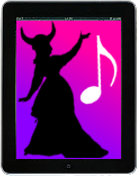A while back, I blogged about wanting an iPad scanning stand that was portable, inexpensive, and would work with bound books. I was planning to make my own stand, but I got lazy and purchased this inexpensive locker shelf instead:
The locker shelf folds flat. Conveniently, I already own a bag that is the right size for it:
Yesterday, I took the locker shelf and my iPad with the Scanner Pro app installed to the music library for a test drive. This time around, I wasn’t scanning scores, but rather a few pages from the Nico Castel libretti books. Here’s what my setup looked like (click any of the images for the full-sized version):
Here’s a sample of the image quality from the original camera image:
And here’s a sample of the image quality after Scanner Pro has fixed the color and converted it to a PDF file:
My observations about the scanning process:
- I ended up not using Scanner Pro’s camera mode for direct document capture because it does not let you make adjustments to the zoom. Fortunately, you can take pictures using the iPad’s regular built-in camera app and then have Scanner Pro import photos from your camera roll to create a multi-page document.
- The library lighting worked well, and the light goes right through the grating of the locker shelf platform and illuminates the page nicely.
- I had to position the iPad so that the the wire mesh of the locker shelf platform did not block the iPad’s back-facing camera (just make sure the camera can peek out through one of the wire “squares” – not too hard).
- With bound books, I had to smooth out pages as best I could with my hand, sometimes even holding them flat with my fingertip while scanning. Even so, the pages still had some perspective skew to them (with the side of the page closer to the camera appearing larger than the further side of the page). This was acceptable for scanning text, but I wouldn’t want this kind of skew when scanning a score. Next time I will try the TurboScan app for iPad – I’ve heard it has some deskewing features (can any readers out there comment on how well the deskewing works?).
- With bound books, the process was not as fast as using a copy machine or flatbed scanner, because of all of the fiddling and positioning and focusing that was necessary. I think scanning loose pages with this method would be a bit faster, as you could just slide the pages in and out from under the locker shelf as you go. Nevertheless, copying many pages from a large bound book would be pretty tedious with the method I used because you kind of have to balance the locker shelf on top of the book and then position the iPad just right to capture the entire page.
- I would like to get some kind of strap, like a small bungee cord or luggage strap, to fasten the iPad to the locker shelf platform and prevent it from slipping off while I’m positioning it:
- The mechanism for holding the locker shelf legs in place is not particularly sturdy. It’s just a groove into which the leg fits:
In the future I might use something simple like small binder clips to secure the legs against collapsing while my iPad is on it:
- Lastly, once Scanner Pro generates the PDF of the libretto pages, it can send the file to Dropbox, where I can then import it into forScore and stick it in a setlist together with my score, so I can have all my music study materials together in one place.
Related Posts:
- Portable scanning of scores & reference materials: smartphones, iPad, scanners
- Preliminary experiments for do-it-yourself iPad scanning stand / document camera
- iPad scanning stand / document camera products
- iPad scanning stand / document camera DIY ideas
- Mixed results using PDF Shrink and PDF optimizer tools on sheet music
- Fast PDF Scores: Get fast, usable versions of scanned music scores
- More posts tagged “scanning”

























